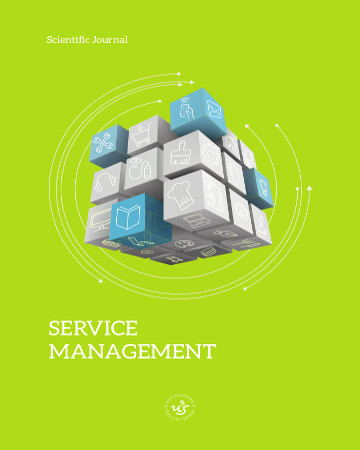
ISSN: 1898-0511
eISSN: 2353-2858
OAI
DOI: 10.18276/smt.2015.15-01


Lista wydań /
Vol. 15, 1/2015
Performance analysis of an inbound call center with time varying arrivals
| Autorzy: |
Maciej
Burak
West Pomeranian University of Technology |
| Słowa kluczowe: | call center continuous time Markov chains CTMC non-stationary model balking abandonment |
| Data publikacji całości: | 2015 |
| Liczba stron: | 7 (5-11) |
Abstrakt
The paper presents a novel method of performance analysis of a call center with balking and abandonment, i.e. in which the customer may not stay in the queue once realizing he is put on hold, or abandon the waiting queue if the waiting time is too long.. In the paper we compare both an inherently transient and a stationary CTMC models of such an inbound call center, using realistic data. The inherently transient method we introduce delivers important characteristics of the model, with the quality close to Monte Carlo simulations, by using modified uniformization method.
Pobierz plik
Plik artykułu
Bibliografia
| 1. | Aksin, Z., Armony, M., & Mehrotra, V. (2007). The modern call center: A multi-disciplinary perspective on operations management research. Production and Operations Management, 16: 665-688. doi:10.1111/j.1937-5956.2007.tb00288.x. |
| 2. | Brown, L., Gans, N., Mandelbaum, A., Sakov, A., Shen, H., Zeltyn, S., Zhao, L. (2005). Statistical analysis of a telephone call center. Journal of the American Statistical Association 100(469): 36–50 |
| 3. | Bylina, J., Bylina, B., Zoła, A., Skaraczynski, T. (2009). A Markovian model of a call center with time varying arrival rate and skill based routing. Computer Networks 2009. Springer Science Business Media: 26–33. |
| 4. | Burak, M. (2014). Multi-step uniformization with steady-state detection in nonstationary m/m/s queuing systems. arXiv preprint arXiv:1410.0804 |
| 5. | Burak, M.(2015). Inhomogeneous CTMC Model of a Call Center with Balking and Abandonment. Studia Informatica Vol.36 No.2(120): 23-34. |
| 6. | Czachórski, T., Fourneau, J.M., Nycz, T., Pekergin, F. (2009). Diffusion approximation model of multiserver stations with losses. Electronic Notes in Theoretical Computer Science 232: 125–143. |
| 7. | Czachórski, T., Nycz, T., Nycz, M., Pekergin, F. (2014). Traffic engineering: Erlang and engset models revisited with diffusion approximation. Information Sciences and Systems 2014. Springer Science – Business Media: 249–256. |
| 8. | Deslauriers, A., L’Ecuyer, P., Pichitlamken, J., Ingolfsson, A., Avramidis, A.N. (2007). Markov chain models of a telephone call center with call blending. Computers &Operations Research 34(6): 1616–1645 |
| 9. | Gans, N., Koole, G., Mandelbaum, (2003). A.: Telephone call centers: Tutorial, review, and research prospects. Manufacturing & Service Operations Management 5(2): 79–141 |
| 10. | Green, L. V., Kolesar, P. J., & Whitt, W. (2007). Coping with time-varying demand when setting staffing requirements for a service system. Production and Operations Management, 16: 13-39. doi:10.1111/j.1937-5956.2007.tb00164.x. |
| 11. | Green, L. V., & Soares, J. (2007). Computing time-dependent waiting time probabilities in m(t)/m/s(t) queuing systems. Manufacturing & Service Operations Management, 9: 54-61. doi:10.1287/msom.1060.0127. |
| 12. | Gross, D., & Miller, D. R. (1984). The randomization technique as a modeling tool and solution procedure for transient Markov processes. Operations Research, 32: 343-361. doi:10.1287/opre.32.2.343. |
| 13. | Haverkort, B. R. (2001). Markovian models for performance and dependability evaluation. Lecture Notes in Computer Science. Springer Science - Business Media:38-83. doi:10.1007/3-540-44667-2_2. |
| 14. | Ingolfsson, A., Akhmetshina, E., Budge, S., Li, Y., & Wu, X. (2007). A survey and experimental comparison of service-level-approximation methods for nonstationary m(t)/m/s(t) queueing systems with exhaustive discipline. INFORMS Journal on Computing, 19: 2 |
| 15. | Ingolfsson, A., Campello, F., Wu, X., & Cabral, E. (2010). Combining integer programming and the randomization method to schedule employees. European Journal of Operational Research, 202: 153-163. doi:10.1016/j.ejor.2009.04.026. |
| 16. | Malhotra, M., Muppala, J. K., & Trivedi, K. S. (1994). Stiffness-tolerant methods for transient analysis of stiff Markov chains. Microelectronics Reliability, 34: 1825-1841. doi:10.1016/0026-2714(94)90137-6. |
| 17. | Phung-Duc, T., Kawanishi, K. (2014). Performance analysis of call centers with abandonment, retrial and after-call work. Performance Evaluation 80: 43–62. |
| 18. | Reibman, A., & Trivedi, K. (1988). Numerical transient analysis of Markov models. Computers & Operations Research, 15: 19-36. doi:10.1016/ 0305-0548(88)90026-3. |
| 19. | Stewart, W. J. (2009). Probability, Markov chains, queues, and simulation: the mathematical basis of performance modeling. Princeton University Press. |
| 20. | Van Moorsel, A. P., & Wolter, K. (1998). Numerical solution of nonhomogeneous Markov processes through uniformization. ESM: 710-717. |